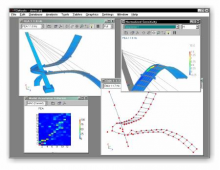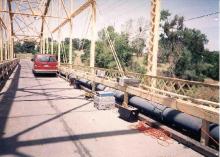|
The California Department Transportation (CALTRANS) funded a research and development project to investigate methods to assess the structural integrity of bridges following earthquakes as well as the structural degradation accumulated over years of use. A project team, consisting of Navcon Engineering, Vibrant Technology & the University of Texas was assembled to develop the basic methodology and conduct two proof of concept tests/analyses. The "general" approach was to:
The project was conducted by:
|
|
The photo shows one of the two suspension bridges tested and analyzed during this project. The bridge was excited using two methods, an APS Dynamics Model 400 electro-dynamic shaker and an impact mass. The test data was acquired using a HP 3566A multi-channel analyzer, PCB Piezotronics signal conditioning, accelerometers and force sensors and Vibrant Technology modal software, ME'Scope. |
|
|
|
|


